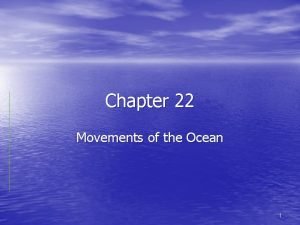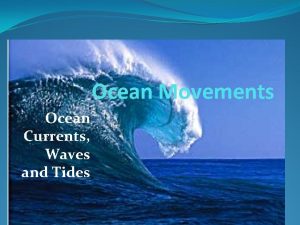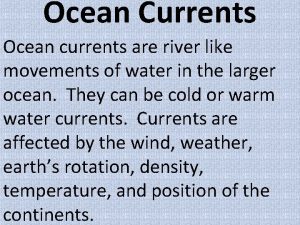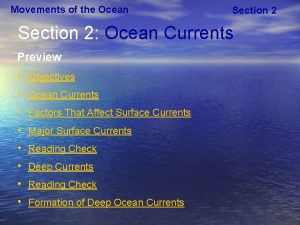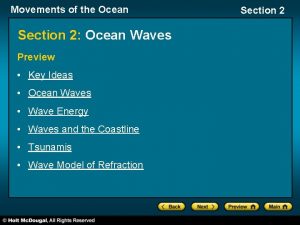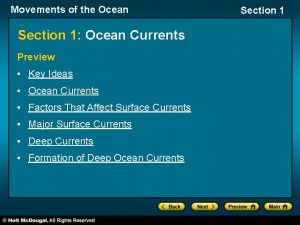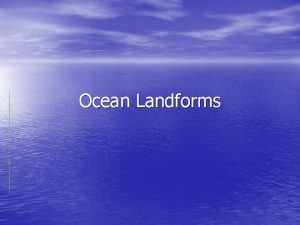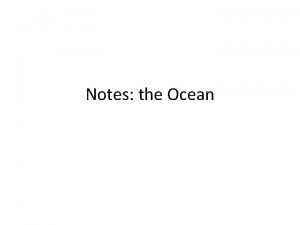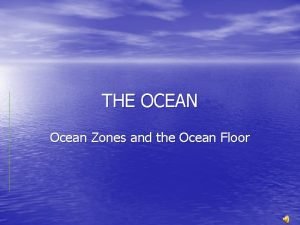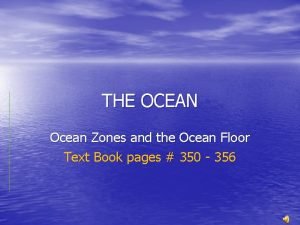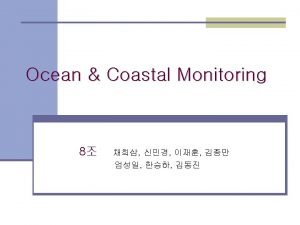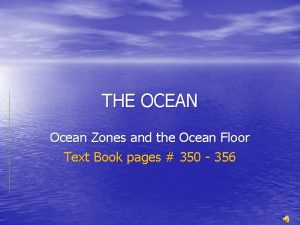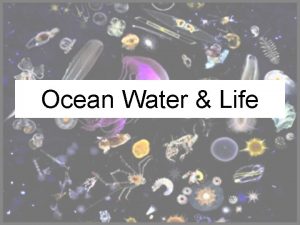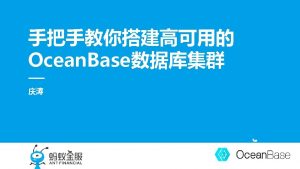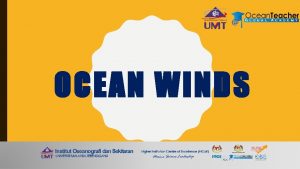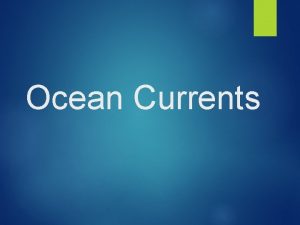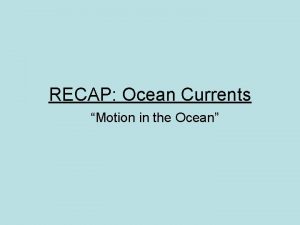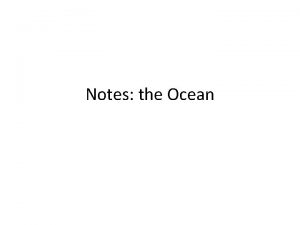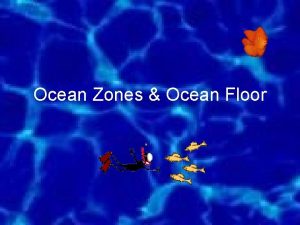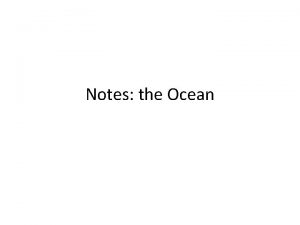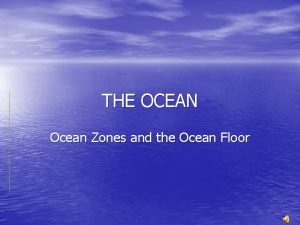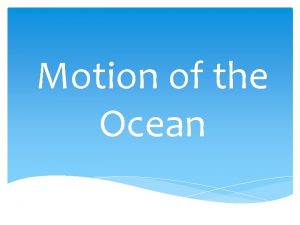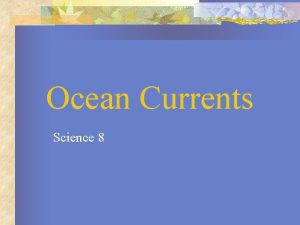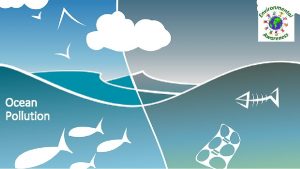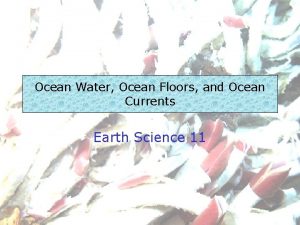Chapter 22 Movements of the Ocean 1 Chapter












































- Slides: 44

Chapter 22 Movements of the Ocean 1

Chapter 22 Section 1 Ocean Currents 2

Section Objectives • Describe how wind patterns, the rotation of Earth, and continental barriers affect surface currents in the ocean. • Identify the major factor that determines the direction in which a surface current circulates. • Explain how differences in the density of ocean water affect the flow of deep currents. 3

22. 1 Ocean Currents • current in geology, a horizontal movement of water in a well-defined pattern, such as a river or stream • Scientists place ocean currents into two major categories: surface currents and deep currents. • surface current a horizontal movement of ocean water that is caused by wind and that occurs at or near the ocean’s surface • deep current a streamlike movement of ocean water far below the surface 4

Surface Currents • Surface currents are controlled by three factors: air currents, Earth’s rotation, and the location of the continents. • Because wind is moving air, wind has kinetic energy. • As energy is transferred from the air to the ocean, the water at the ocean’s surface begins to move. 5

Factors Affecting Ocean Currents Global Wind Belts • Global wind belts, such as the trade winds and westerlies, are a major factor affecting the flow of ocean surface water. • In both hemispheres, trade-wind belts push currents westward across the tropical latitudes of all three major oceans. • Westerlies push ocean currents eastward in the higher latitudes of the Northern and Southern Hemispheres. 6

Factors Affecting Ocean Currents The Coriolis Effect Coriolis effect the apparent curving of the path of a moving object from an otherwise straight path due to Earth’s rotation • Wind belts and ocean currents follow a curved or circular pattern that is caused by Earth’s rotation. 7

Factors Affecting Ocean Currents The Coriolis Effect, continued gyre a huge circle of moving ocean water found above and below the equator • Wind belts and the Coriolis effect cause huge circles of moving water, called gyres, to form. • In the Northern Hemisphere, water flow in gyres is to the right, or clockwise. In the Southern Hemisphere, the flow is to the left, or counterclockwise. 8

Factors Affecting Ocean Currents Continental Barriers • The continents are another major influence on surface currents. • The continents act as barriers to surface currents. • When a surface current flows against a continent, the current is deflected and divided. 9

Equatorial Currents • Warm equatorial currents are located in the Atlantic, Pacific, and Indian Oceans. • Each of these oceans has two warm-water equatorial currents that move in a westward direction. • Between these westward-flowing currents lies a weaker, eastward-flowing current called the Equatorial Countercurrent. 10

Currents in the North Atlantic & Pacific Gulf Stream the swift, deep, and warm Atlantic current that flows along the eastern coast of the United States toward the north • South of Greenland, the Gulf Stream widens and slows until it becomes a vast, slow-moving warm current known as the North Atlantic Current. • The Gulf Stream, the North Atlantic Current, the Canary Current, and the North Equatorial Current form the North Atlantic Gyre. • At the center of this gyre lies a vast area of calm, warm water called the Sargasso Sea. 11

Currents in the North Pacific • The patterns of currents in the North Pacific is similar to that in the North Atlantic. • The warm Japan Current (Kuroshio Current), the Pacific equivalent of the Gulf Stream, flows northward along the east coast of Asia. This current then flows toward North America as the North Pacific Drift. • It eventually flows southward along the California coast as the cool California Current. 12

Currents in the Southern Hemisphere • In the most southerly regions of the oceans, constant westward winds produce the world’s largest current, the Antarctic Circumpolar Current, also known as West Wind Drift. • No continents interrupt the movement of this current that completely circles Antarctica and crosses all three major oceans. 13

Deep Currents deep current a streamlike movement of ocean water far below the surface • Deep currents form as cold, dense water of the polar regions sinks and flows beneath warmer ocean water. • The movement of polar waters is a result of differences in density. • Temperature determines density. Salinity, too, determines the density of water. 14

Antarctic Bottom Water • The temperature of the water near Antarctica is very cold, 2°C. The water’s salinity is high. These two factors make the water off the coast of Antarctica the densest and coldest ocean water in the world. • This dense, cold water sinks to the ocean bottom and forms a deep current called the Antarctic Bottom Water. 15

North Atlantic Deep Water • In the North Atlantic, south of Greenland, the water is very cold and has a high salinity. This cold, salty water forms a deep current that moves southward under the northward flowing Gulf Stream. • The dense, highly saline water of the Mediterranean Sea forms a deep current as it flows through the strait of Gibraltar and into the less dense Atlantic Ocean. 16

Turbidity Currents • A turbidity current is a strong current caused by an underwater landslide. • The sediment causes the water to become cloudy, or turbid, and denser than the surrounding water. • The dense water mass of the turbidity current moves beneath the less dense, clear water. 17

22. 1 Review 1. What force drives most of the surface currents 2. 3. 4. 5. of the oceans? Which winds affect the surface currents on either side of the equator? Which winds affects the surface currents in the middle latitudes of both hemispheres? What two factors affect the density of ocean water and cause deep currents? Explain the role of density in turbidity currents? 18

Major Surface Currents The diagram below shows the major surface currents of Earth’s oceans. 19

Chapter 22 Section 2 Ocean Waves 20

22. 2 Section Objectives • Describe the formation of waves and the factors that affect wave size. • Explain how waves interact with the coastline. • Identify the cause of destructive ocean waves. 21

22. 2 Ocean Waves wave: the periodic up-and-down movement of water. • two basic parts—a crest and a trough. – crest = highest point – trough = lowest point wave period the time required for two consecutive wave crests to pass a given point • The wave height is the vertical distance between the crest and the trough of a wave. • The wavelength is the horizontal distance between two consecutive crests or between two consecutive troughs. 22

Wave Energy • Main source of wave energy = wind • The longer that wind blows from a given direction = more energy is transferred from wind to water = the larger the wave becomes. • Because of their large surface area, larger waves receive more energy from the wind than smaller waves do. • Thus, larger waves grow larger, and smaller waves die out. 23

Water Movement in a Wave • Energy of a wave moves from water molecule to • • • water molecule in the direction of the wave; the water itself moves very little. Only the energy of the wave, not the water, moves in the direction of the wave. The water molecule within the wave move in a circular motion. During a single wave period, each water particle moves in one complete circle. As a wave passes a given point, the circle traced by a water particle on the ocean surface has a diameter that is equal to the height of the wave. 24 24

Wave Size fetch the distance that wind blows across an area of the sea to generate waves • Three factors determine the size of a wave. These factors are the speed of the wind, the length of time the wind blows, and fetch. • The size of a wave will increase to only a certain height-to-length ratio before the wave collapses. 25

Waves and the Shore • In shallow water near the coastline, the bottom of a wave touches the ocean floor. • A wave touches the ocean bottom where the depth of the water is about half the wavelength. • Contact with the ocean floor creates drag, causing the wave to slow and break. 26

Breakers • As the wave moves into shallow water, the bottom of the wave is slowed by friction. The top of the wave, however, continues to move at its original speed. • Finally, the top of the wave topples over and forms a breaker, a foamy mass of water that washes onto the coastline. 27

Refraction refraction the process by which ocean waves bend directly toward the coastline as they approach shallow water, the part of the wave that is traveling in shallow water travels more slowly than the part of the wave that is still advancing in deeper water. • The wave gradually bends toward the beach and strikes the shore head-on. 28

Undertows & Rip Currents • Water carried onto a beach by breaking waves is pulled back into deeper water by gravity. This motion forms an irregular current called an undertow. • The generally weak undertow is often confused with the more dangerous rip current. • Rip currents form when water from larger breakers returns to the ocean through channels that cut through underwater sandbars that are parallel to the beach. 29

Longshore Currents • Longshore currents form when waves approach the beach at an angle. • Longshore currents flow parallel to the shore. Great quantities of sand are carried by longshore currents. • These sand deposits form low ridges of sand called sandbars. 30

Tsunamis • Tsunamis are giant seismic ocean waves. • Most tsunamis are caused by earthquakes on the ocean floor, but some can be caused by volcanic eruptions and underwater landslides. • Tsunamis are commonly called tidal waves, which is misleading because tsunamis are not caused by tides. • A tsunami has a tremendous amount of energy. • All of the energy of this mass of water is released against the shore and causes a great deal of destruction. • The arrival of a tsunami may be signaled by the sudden pulling back of the water along the shore. 31

Section 22. 2 Review 1. Explain how wave height, wavelength, and wave 2. 3. 4. 5. period are determined from the crest and trough of a wave. What factors determine the size of the wave? Why do incoming waves bend toward the beach until they strike the shore head-on? What is the cause of most tsunamis? Explain why waves slow down in shallow water. 32

Chapter 22 Section 3 Tides 33

Section 22. 3 Objectives • Describe how the gravitational pull of the moon causes tides. • Compare spring tides and neap tides. • Describe how tidal oscillations affect tidal patterns. • Explain how the coastline affects tidal currents. 34

22. 3 Tides the periodic rise and fall of the water level in the oceans and other large bodies of water • High tide is when the water level is highest. • Low tide is when the water level is lowest. 35

Cause of Tides • The gravitational effects of the moon and, to a lesser extent, the sun causes tides. • Gravitational pull of the moon is strongest on the side of Earth that is nearest to the moon. • As a result, the ocean on Earth’s near side bulges slightly, which causes a high tide within the area of the bulge. • Low tides form halfway between two high tides. Low tides form because as ocean water flows toward areas of high tide, the water level in other areas of the oceans drop. 36

Behavior of Tides tidal range the difference in levels of ocean water at high tide and low tide • Because there are two tidal bulges, most locations in the ocean have two high tides and two low tides daily. • The tidal range can vary widely from place to place. • Because the moon rises about 50 minutes later each day, the times of high and low tides are about 50 minutes later each day. 37

Spring Tides • The sun’s gravitational pull can strengthen or weaken the moon’s influence on the tides. • During the new moon and the full moon, Earth, the sun, and the moon are aligned. The combined gravitational pull of the sun and the moon results in higher high tides and lower low tides. • During these two monthly periods, tides are called spring tides. 38

Neap Tides • During the first- and third-quarter phases of the moon, the moon and the sun are at right angles to each other in relation to Earth. • The gravitational forces of the sun and moon work against each other. • As a result, the daily tidal range is small. Tides that occur during this time are called neap tides. 39

Spring Tide/Neap Tide 40

Tidal Variations • Tidal patterns are greatly influenced by the size, shape, depth, and location of the ocean basin in which the tides occur. • Along the Atlantic Coast of the United States, two high tides and two low tides occur each day and have a fairly regular tidal range. • Along the shore of the Gulf of Mexico, however, only one high tide and one low tide occur each day. 41

Tidal Variations (more) tidal oscillation the slow, rocking motion of ocean water that occurs as the tidal bulges move around the ocean basins • In some enclosed seas tidal oscillations reduce the effects of the tidal bulges. • However, in small basins and narrow bays located off major ocean basins, tidal oscillations may amplify the effects of the 42 tidal bulges.

Tidal Currents tidal current the movement of water toward and away from the coast as a result of the rise and fall of the tides • When the tidal current flows toward the coast, it is called flood tide. • When the tidal current flows toward the ocean, it is called ebb tide. • When there are no tidal currents, the time period between flood tide and ebb tide is called slack water. 43

Section 22. 3 Review 1. 2. 3. 4. What causes tides? What are spring tides? Neap tides? Where might tidal currents be of concern to ships approaching land? What factors influence tidal patterns in a particular location? 44
 Locomotor
Locomotor Chapter 15 ocean water and ocean life answer key
Chapter 15 ocean water and ocean life answer key Streamlike movements of water in the ocean called
Streamlike movements of water in the ocean called Convergent boundary
Convergent boundary Ocean ocean convergent boundary
Ocean ocean convergent boundary Convergent plate boundaries
Convergent plate boundaries Ocean ocean convergent boundary
Ocean ocean convergent boundary Convergent plate boundary
Convergent plate boundary Ocean to ocean convergent boundary
Ocean to ocean convergent boundary Red ocean blue ocean strategi
Red ocean blue ocean strategi Hình ảnh bộ gõ cơ thể búng tay
Hình ảnh bộ gõ cơ thể búng tay Slidetodoc
Slidetodoc Bổ thể
Bổ thể Tỉ lệ cơ thể trẻ em
Tỉ lệ cơ thể trẻ em Chó sói
Chó sói Chụp phim tư thế worms-breton
Chụp phim tư thế worms-breton Hát lên người ơi alleluia
Hát lên người ơi alleluia Các môn thể thao bắt đầu bằng tiếng đua
Các môn thể thao bắt đầu bằng tiếng đua Thế nào là hệ số cao nhất
Thế nào là hệ số cao nhất Các châu lục và đại dương trên thế giới
Các châu lục và đại dương trên thế giới Công của trọng lực
Công của trọng lực Trời xanh đây là của chúng ta thể thơ
Trời xanh đây là của chúng ta thể thơ Cách giải mật thư tọa độ
Cách giải mật thư tọa độ Phép trừ bù
Phép trừ bù độ dài liên kết
độ dài liên kết Các châu lục và đại dương trên thế giới
Các châu lục và đại dương trên thế giới Thơ thất ngôn tứ tuyệt đường luật
Thơ thất ngôn tứ tuyệt đường luật Quá trình desamine hóa có thể tạo ra
Quá trình desamine hóa có thể tạo ra Một số thể thơ truyền thống
Một số thể thơ truyền thống Bàn tay mà dây bẩn
Bàn tay mà dây bẩn Vẽ hình chiếu vuông góc của vật thể sau
Vẽ hình chiếu vuông góc của vật thể sau Biện pháp chống mỏi cơ
Biện pháp chống mỏi cơ đặc điểm cơ thể của người tối cổ
đặc điểm cơ thể của người tối cổ Ví dụ về giọng cùng tên
Ví dụ về giọng cùng tên Vẽ hình chiếu đứng bằng cạnh của vật thể
Vẽ hình chiếu đứng bằng cạnh của vật thể Phối cảnh
Phối cảnh Thẻ vin
Thẻ vin đại từ thay thế
đại từ thay thế điện thế nghỉ
điện thế nghỉ Tư thế ngồi viết
Tư thế ngồi viết Diễn thế sinh thái là
Diễn thế sinh thái là Các loại đột biến cấu trúc nhiễm sắc thể
Các loại đột biến cấu trúc nhiễm sắc thể Các số nguyên tố
Các số nguyên tố Tư thế ngồi viết
Tư thế ngồi viết Lời thề hippocrates
Lời thề hippocrates


